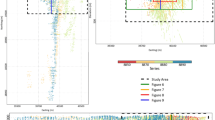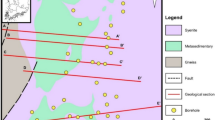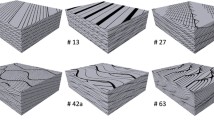Abstract
High-resolution spatial numerical models of metallurgical properties constrained by geological controls and more extensively by measured grade and geomechanical properties constitute an important part of geometallurgy. Geostatistical and other numerical techniques are adapted and developed to construct these high-resolution models accounting for all available data. Important issues that must be addressed include unequal sampling of the metallurgical properties versus grade assays, measurements at different scale, and complex nonlinear averaging of many metallurgical parameters. This paper establishes techniques to address each of these issues with the required implementation details and also demonstrates geometallurgical mineral deposit characterization for a copper–molybdenum deposit in South America. High-resolution models of grades and comminution indices are constructed, checked, and are rigorously validated. The workflow demonstrated in this case study is applicable to many other deposit types.












Similar content being viewed by others
References
Aitchison, J. (1982). The statistical analysis of compositional data. Journal of the Royal Statistical Society: Series B (Methodological), 44(2), 139–177.
Alabert, F. G. (1987). Stochastic imaging of spatial distributions using hard and soft information. Master’s Thesis, Stanford University, Stanford, CA.
Babak, O., Cuba, M. A., & Leuangthong, O. (2013). Direct upscaling of semivariograms and cross semivariograms for scale-consistent geomodeling. Transactions of the Society for Mining, Metallurgy, and Exploration, 334(1), 544–552.
Babak, O., & Deutsch, C. (2009a). Accounting for parameter uncertainty in reservoir uncertainty assessment: The conditional finite-domain approach. Natural Resources Research, 18(1), 7–17.
Babak, O., & Deutsch, C. (2009b). Collocated cokriging based on merged secondary attributes. Mathematical Geosciences, 41(8), 921–926.
Barnett, R., & Deutsch, C. (2012). Practical implementation of nonlinear transforms for modeling geometallurgical variables. In P. Abrahamsen, R. Hauge, & O. Kolbjørnsen (Eds.), Geostatistics Oslo 2012 (Vol. 17, pp. 409–422). Netherlands: Springer.
Barnett, R. M., & Deutsch, C. V. (2013). Imputation of geologic data. Centre for Computational Geostatistics, 15(102).
Barnett, R. M., & Deutsch, C. V. (2015). Multivariate imputation of unequally sampled geologic variables. Mathematical Geosciences,. doi:10.1007/s11004-014-9580-8.
Barnett, R. M., Manchuk, J. G., & Deutsch, C. V. (2013). Projection pursuit multivariate transform. Mathematical Geosciences, 46(3), 337–359.
Bliss, C. I. (1934). The method of probits. Science, 79(2037), 38–39.
Boisvert, J. B., Rossi, M. E., Ehrig, K., & Deutsch, C. V. (2013). Geometallurgical modeling at Olympic Dam Mine, South Australia. Mathematical Geosciences, 1–25.
Carrasco, P., Chiles, J., & Seguret, S. (2008). Additivity, metallurgical recovery and grade. Paper presented at the Geostats 2008, Santiago, Chile.
Chilès, J. P., & Delfiner, P. (2012). Geostatistics: Modeling Spatial Uncertainty (2nd ed.). New York: Wiley.
Coward, S., Vann, J., Dunham, S., & Stewart, M. (2009). The primary-response framework for geometallurgical variables. Paper presented at the Seventh International Mining Geology Conference 2009, Perth, Western Australia.
Davis, B., & Greenes, K. (1983). Estimation using spatially distributed multivariate data: An example with coal quality. Journal of the International Association for Mathematical Geology, 15(2), 287–300.
Desbarats, A. J., & Dimitrakopoulos, R. (2000). Geostatistical simulation of regionalized pore-size distributions using min/max autocorrelation factors. Mathematical Geology, 32(8), 919–942.
Deutsch, J. L., & Deutsch, C. V. (2010). Some geostatistical software implementation details. Centre for Computational Geostatistics, 12(412).
Deutsch, C. V., & Journel, A. G. (1998). GSLIB: Geostatistical software library and user’s guide (2nd ed.). New York: Oxford University Press.
Deutsch, C. V., & Wilde, B. J. (2013). Modeling multiple coal seams using signed distance functions and global kriging. International Journal of Coal Geology, 112, 87–93.
Dimitrakopoulos, R., & Jewbali, A. (2013). Joint stochastic optimization of short- and long- term mine production planning: Method and application in a large operating gold mine. IMM Transactions, Mining Technology, 122(2), 110–112.
Efron, B. (1982). The jackknife, the bootstrap and other resampling plans. Society for Industrial and Applied Mathematics.
Enders, C. K. (2010). Applied missing data analysis. Guilford Press.
Everett, J. E., & Howard, T. J. (2011). Predicting finished product properties in the mining industry from pre-extraction data. Paper presented at the The First AusIMM International Geometallurgy Conference, Brisbane, Queensland.
Fedkiw, S. O. R. (2003). Level set methods and dynamic implicit surfaces. New York: Springer.
Galli, A., Beucher, H., Leloch, G., & Doligez, B. (1994). The pros and cons of the truncated Gaussian method. Geostatistical Simulations: Proceedings of the Geostatistical Simulation Workshop, 7, 217–233.
Goovaerts, P. (1997). Geostatistics for natural resources evaluation. New York: Oxford University Press.
Isaaks, E. H. (1990). The application of Monte Carlo methods to the analysis of spatially correlated data. PhD Thesis, Stanford University, Stanford, CA.
Journel, A., & Xu, W. (1994). Posterior identification of histograms conditional to local data. Mathematical Geology, 26(3), 323–359.
Keeney, L., & Walters, S. (2011). A methodology for geometallurgical mapping and orebody modelling. Paper presented at the The First AusIMM International Geometallurgy Conference, Brisbane, Queensland.
Kuhar, L. L., Jeffrey, M. I., McFarlane, A. J., Benvie, B., Botsis, N. M., Turner, N. & Robinson, D. J. (2011). The development of small-scale tests to determine hydrometallurgical indices for orebody mapping and domaining. Paper presented at the The First AusIMM International Geometallurgy Conference, Brisbane, Queensland.
Leuangthong, O., Hodson, T., Rolley, P., & Deutsch, C. V. (2006). Multivariate geostatistical simulation at Red Dog mine, Alaska, USA. CIM Bulletin, 99(1094), 10.
Lozano, C., & Bennett, C. (2003). Geometallurgical modeling applied to production forecasting, plant design and optimisation. SGS Metallurgical Services Technical Report.
Lund, C., Lamberg, P., & Lindberg, T. (2014). A new method to quantify mineral textures for geometallurgy. Cape Town: Paper presented at Process Mineralogy.
Manchuk, J. G., & Deutsch, C. V. (2012). A flexible sequential Gaussian simulation program: USGSIM. Computers & Geosciences, 41, 208–216.
Marchant, B. P., & Lark, R. M. (2004). Estimating Variogram Uncertainty. Mathematical Geology, 36(8), 867–898.
Moyeed, R. A., & Papritz, A. (2002). An empirical comparison of kriging methods for nonlinear spatial point prediction. Mathematical Geology, 34(4), 365–386.
Newton, M. J., & Graham, J. M. (2011). Spatial modelling and optimisation of geometallurgical indices. Paper presented at the The First AusIMM International Geometallurgy Conference, Brisbane, Queensland.
Ortiz, J., & Deutsch, C. (2002). Calculation of uncertainty in the variogram. Mathematical Geology, 34(2), 169–183.
Pardo-Igúzquiza, E., & Dowd, P. (2001). Variance-covariance matrix of the experimental variogram: Assessing variogram uncertainty. Mathematical Geology, 33(4), 397–419.
Pawlowsky-Glahn, V., & Olea, R. A. (2004). Geostatistical analysis of compositional data. USA: Oxford University Press.
Powell, M. S. (2013). Utilising orebody knowledge to improve comminution circuit design and enery utilisation. Paper presented at the The Second AusIMM International Geometallurgy Conference, Brisbane, Australia.
Pyrcz, M. J., & Deutsch, C. V. (2014). Geostatistical reservoir modeling. Oxford: Oxford University Press.
Pyrcz, M. J., Gringarten, E., Frykman, P., & Deutsch, C. V. (2006). Representative input parameters for geostatistical simulation. In T. C. Coburn, J. M. Yarus, & R. L. Chambers (Eds.), Stochastic modeling and geostatistics: Principles, methods, and case studies, volume II: AAPG Computer Applications in Geology (Vol. 5, pp. 123–137). New York: Wiley.
Rossi, M. E., & Deutsch, C. V. (2013). Mineral resource estimation. New York: Springer Science & Business Media.
Silva, D. A., & Deutsch, C. V. (2013). Correcting distance function models to correct proportions. Centre for Computational Geostatistics, 15(116), 1–10.
Switzer, P., & Green, A. A. (1984). Min/max autocorrelation factors for multivariate spatial imagery. In L. Billard (Ed.), Computer Science and Statistics: The Interface (Vol. 16). Amsterdam: Elsevier.
van den Boogaart, K. G., Konsulke, S., & Tolosana Delgado, R. (2013). Non-linear geostatistics for geometallurgical optimisation. Paper presented at the The Second AusIMM International Geometallurgy Conference, Brisbane, Australia.
Van Tonder, E., Deglon, D. A., & Napier-Munn, T. J. (2010). The effect of ore blends on the mineral processing of platinum ores. Minerals Engineering, 23(8), 621–626.
Vargas-Guzmán, J. A., & Dimitrakopoulos, R. (2003). Computational properties of min/max autocorrelation factors. Computers & Geosciences, 29(6), 715–723.
Yan, D., & Eaton, R. (1994). Breakage properties of ore blends. Minerals Engineering, 7(2–3), 185–199.
Acknowledgments
Many discussions on best practices in multivariate geostatistical modeling with Ryan Barnett and other colleagues at the Centre for Computational Geostatistics are gratefully acknowledged. The input of Bryan Rairdan, Rodrigo Marinho, the editor of Natural Resources Research, and three anonymous reviewers is also much appreciated.
Author information
Authors and Affiliations
Corresponding author
Rights and permissions
About this article
Cite this article
Deutsch, J.L., Palmer, K., Deutsch, C.V. et al. Spatial Modeling of Geometallurgical Properties: Techniques and a Case Study. Nat Resour Res 25, 161–181 (2016). https://doi.org/10.1007/s11053-015-9276-x
Received:
Accepted:
Published:
Issue Date:
DOI: https://doi.org/10.1007/s11053-015-9276-x




